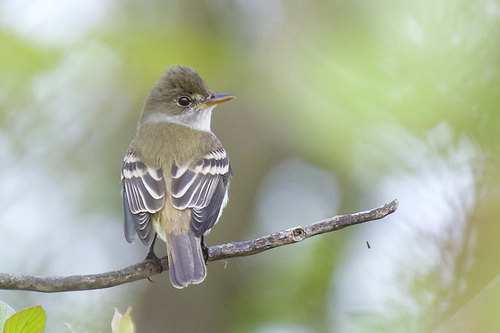
Willow Flycatcher
The Willow Flycatcher (*Empidonax traillii*) is a small, Neotropical migratory songbird found across North America. It is a member of the tyrant flycatcher family, known for their aerial hawking behavior of catching insects in flight. This species plays a vital role in controlling insect populations within its riparian and shrubby habitats. While not particularly flashy in appearance, its distinctive "fitz-bew" song is a characteristic sound of wet meadows and willow thickets during the breeding season. The Willow Flycatcher's preference for these specific habitats makes it an indicator species, meaning its presence and population trends can reflect the overall health of these ecosystems.
13-17 cm
Length
20-24 cm
Wingspan
Least Concern
Conservation Status
Distribution
The Willow Flycatcher breeds across much of the United States and southern Canada. Its wintering range extends from southern Mexico through Central America and into northern South America. Migratory routes vary depending on the breeding population, with some birds traveling thousands of miles. They typically occupy low to mid-elevations.
Lifespan
The average lifespan in the wild is not well-documented, but likely around 2-3 years, with a maximum recorded lifespan of over 8 years.
Willow Flycatcher's Habitat
Habitat Types
Riparian woodlands, Shrubby wetlands, Wet meadows, Willow thickets, Alders edges
Climate Zones
Temperate, Subtropical
Adaptations
Willow Flycatchers have a slight preference for dense, low-lying vegetation near water sources. This provides cover from predators, ample insect prey, and suitable nesting sites. Their relatively broad bill is adapted for catching a wide variety of flying insects.
Variations
Several subspecies of Willow Flycatcher are recognized, differing subtly in plumage color and song. These variations often correlate with geographic regions, such as the Southwestern Willow Flycatcher (*Empidonax traillii extimus*), which is an endangered subspecies.
Appearance
Breeding Plumage
Plumage is generally similar year-round. Adults are olive-brown above and pale below, with a whitish throat and faint wing bars. The breast often has a slight olive wash.
Seasonal Feather Changes
Minimal seasonal variation; plumage may appear slightly fresher after molting.
Sex Based Plumage Differences
Males and females are visually indistinguishable.
Notable Features
Faint white eye-ring, Two pale wing bars, Lack of a prominent crest (unlike some other *Empidonax* flycatchers), Slightly notched tail
Diet and Feeding
Primary Foods
Flying insects, Beetles, Wasps, Flies, Moths, Caterpillars, Small berries (occasionally)
Foraging Behavior
Willow Flycatchers primarily employ a 'sit-and-wait' strategy, perching on exposed branches and sallying out to catch insects in mid-air. They also glean insects from foliage.
Specializations
Their relatively wide bill and agile flight allow them to capture a diverse range of insect prey. They are also known to hover briefly while foraging.
Seasonal Diet Variations
The diet is primarily insectivorous during the breeding season. In the non-breeding season, and during migration, they may consume more small fruits and berries when insects are less abundant.
Behavior
Social Structure
Willow Flycatchers are generally solitary or found in pairs during the breeding season. They are not known to form large flocks.
Communication
Distinctive "fitz-bew" song (primary territorial and mate attraction call), "Whit" call (contact call), Bill snapping (during aggressive encounters)
Migration
Willow Flycatchers are Neotropical migrants, undertaking long-distance migrations between their breeding and wintering grounds. The timing and routes are influenced by weather patterns and food availability.
Territorial or Group Behaviors
Males are highly territorial during the breeding season, defending their nesting areas against other males. Females may also engage in territorial defense.
Conservation
Threats
Habitat loss (due to agriculture, urbanization, and water management), Pesticide use (reducing insect prey), Brood parasitism by Brown-headed Cowbirds, Climate change (altering habitat suitability)
Protection Programs
Endangered Species Act (for the Southwestern Willow Flycatcher), Habitat restoration projects, Monitoring programs
Local National Laws
Protected under the Migratory Bird Treaty Act in the United States.
Population Trend
Overall, the population is considered stable, but some regional declines have been observed, particularly in the southwestern United States.
Population Estimates
The global population is estimated to be around 6.9 million individuals.
Interesting Facts
The Southwestern Willow Flycatcher is a federally endangered subspecies.
Its decline is primarily due to habitat loss and degradation along rivers and streams in the arid Southwest.
Willow Flycatchers are often difficult to distinguish visually from other *Empidonax* flycatchers.
Their song is often the most reliable way to identify them.
They can be surprisingly aggressive towards larger birds that intrude on their territory.
They will chase away hawks, crows, and other potential predators.
Faqs about Willow Flycatcher
What is the best way to attract Willow Flycatchers to my yard?
Providing suitable habitat is key. Planting native willows, shrubs, and other vegetation near a water source can make your yard more attractive to them.
How can I tell a Willow Flycatcher from an Alder Flycatcher?
The best way is by their song. The Willow Flycatcher says "fitz-bew," while the Alder Flycatcher says "fee-bee-o." Visually, they are extremely similar.
Are Willow Flycatchers beneficial to have around?
Yes, they are excellent at controlling insect populations, including mosquitoes and other biting flies.
Copyright @ Nature Style Limited. All Rights Reserved.
 English
English